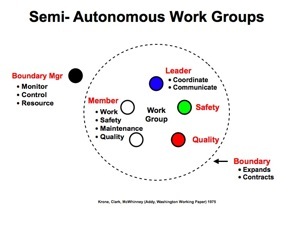


Bridging the Gap



2. Semi-Autonomous Work Groups(5:20)
The concept of work teams or work groups has been around for a long time. They have been called Self-direct Work Teams, Autonomous Work Groups, Semi-Autonomous Work Groups, High Performance Teams, etc. No matter what they are called, they all have some things in common, more autonomy in the work place, more control over the decisions affecting them, higher employee satisfaction and higher performance/productivity then the closely supervised traditional crew.
When people think of these type of groups, they often believe they are totally self governing. Although they are have more autonomy, they still report to form of management. The amount of autonomy that they have is determined by the leadership maturity of Management and the ability and willingness of the team members.
Several organizations have experimented with these types of groups including, Alcoa, Procter & Gamble, Shell Oil, Volvo, United Auto Workers, Canadian Chemical Workers (Sarnia Canada), etc. with varying degrees of success. Most failures occurred because of the lack of clear boundaries, unclear roles, poor interpersonal skills and unclear managerial leadership/direction.
It is important that member, leader and managerial roles are clear and that the work group & team managers understand the boundaries around the work group and each manages them effectively.
Reference
The above information was gathered from the work of: Charles Krone, James Clark, Will McWhinney (Open Systems Planning Redesign 1972), Bob Crosby, Patricia Crosby, Tom McCombs (Addy, 1975 - 2000), William Pasmore, John Sherwood (Sociotechnical Systems a source book, University Associates 1978), James Taylor, David Felton, (Performance By Design - Sociotechnical Systems in North America) and Tom McCombs (30 yrs experience in work team systems).



